SAP S/4HANA Intercompany Matching and Reconciliation (ICMR)
SAP S/4HANA Intercompany Matching and Reconciliation (ICMR).
Abstract
With a significant increase in the number of mergers & acquisitions, organisations now face different challenges. One of them is Intercompany Reconciliations. Many companies might be looking to perform this reconciliation in a cost efficient & transparent way that avoids delay in closing the books. SAP S/4HANA’s Intercompany Matching & Reconciliation Functionality helps them to perform these tasks. S/4HANA Consultants can write flexible matching & reconciliation rules. S/4HANA Customers with this functionality will have high visibility of the reconciliation process and they can have user-friendly Fiori apps to manage matching assignments in aggregate or at the line item level. This helps to accelerate the month-end closing process.
Introduction:
SAP S/4HANA’s ICMR (Intercompany Matching & Reconciliation) Functionality introduced from 1909 in On-premise versions and 1908 for Cloud versions. ICMR supports users to analyse intercompany differences and reduces delays during the month-end closing process. Differences might occur due to timing or currency, etc. This new functionality avoids ETL process and Matching is designed by directly accessing ACDCOA table or external data. This helps in accelerating the intercompany reconciliation process. It is a built-in solution in SAP S/4HANA. Customers can define flexible matching & reconciliation rules.
Intercompany document items can be auto-matched line by line using a matching engine. Matching rules can be defined based on your business case either flexibly or with exact-match patterns. We can also schedule background jobs for matching run. Users can check the matching results & process the discrepancies. We can also define workflows and auto adjustment for differences. Customer can use a predefined workflow scenario WS78500087 for the difference adjustment approval. We can define different reason codes for different cases like perfectly matched, nearly matched and differences.
ICMR functionality is available from SAP S/4HANA 1909. It reads data from other systems also along with the functionalities offered by the old ICR functionality from earlier versions. The new functionality has reports for showing reconciliation status & balances with the drilldown capability to individual documents. It supports multi-dimension reconciliation and users can use Fiori apps.
The New ICMR consists of:
- Matching: Deals with transactional-level matching
- Reconciliation: presents an aggregation-level view
- Automatic Posting: function for variance adjustment, accrual postings, or elimination postings.
How to migrate from ERP ICR to S/4HANA ICMR?
If Customers have SAP ERP Intercompany (ICR) solution and want to migrate data to SAP S/4HANA Intercompany Matching & Reconciliation (ICMR). The historically matched (reconciled) data needs to be first exported from the tables (for example, FBICRC003A) of your ERP systems, then imported to the table ICADOCM of SAP S/4HANA. Refer SAP Note 2932076 - ICR Data migration ( SAP ERP ICR system to S/4HANA ICMR )
A Basic overview of SAP S/4HANA ICMR configuration:
- Configuration overview for SAP S/4HANA On-Premise systems
- Standard Content Information
- Matching Methods
- Organisational Hierarchy
- Defining Reconciliation cases
- Reason codes definition
- Define GL Posting Document template and assign to companies
- Workflows for difference adjustments
- Activate Reconciliation Close Process
- Define Elimination Posting Rules
- Define Elimination Methods
- Define Data Sources
1. Configuration overview for SAP S/4HANA On-Premise systems
System must be at least on SAP S/4HANA 1909
Assign below role (Transaction code PFCG) SAP_BR_RECON_ACCOUNTANT SAP_BR_ADMINISTRATOR_GRP.
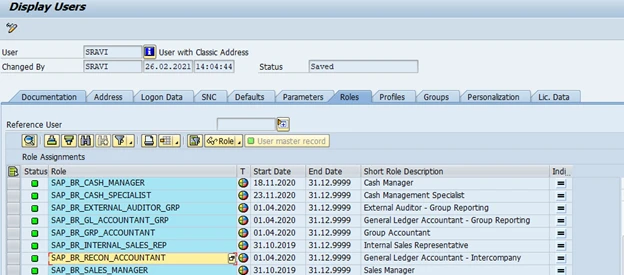
So relevant Fiori apps appear on your Fiori launchpad.
Activate Best Practices Content 40Y. or if you are also using Group Reporting activate 1SG
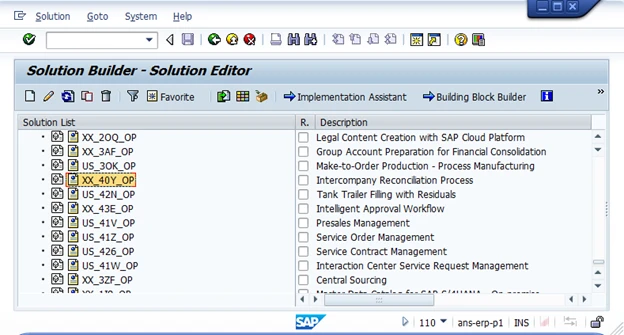
Transaction code ICAIMG for IMG Activities
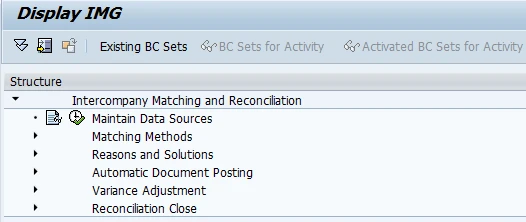
Follow the below latest SAP note for Best Practices Content

2. Standard Content Information
Refer to the latest SAP Note 2965516 for SAP S/4HANA 2020 for a complete content list

3. Define Matching Methods
It is a collection of matching rules used to match items.
Fiori app: Define Matching Methods

On this screen you can see SAP delivered matching method

I have used the same method in my example. If need be, copy and create your own.

Data Source
It defines where the data comes from and what the org dimension is.
SF_JOURNAL_ENTRIES_01

You can see matching rules:

Define matching expressions of each rule:

4. Organisational hierarchy
Organisational hierarchy will be used in the Reconciliation Status Overview.
Use SAP Fiori app: Manage Global Hierarchies
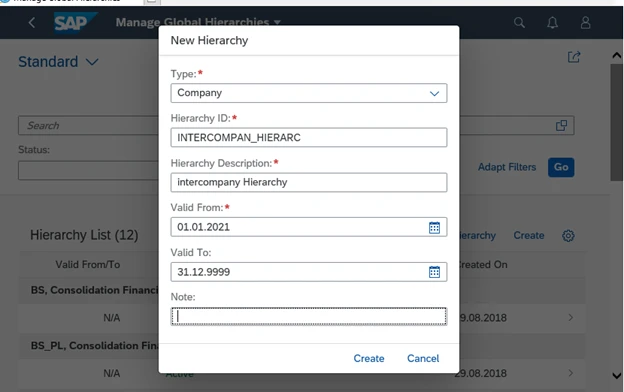
5. Define Reconciliation Cases
Reconciliation case is based on a matching method. It consists of display groups. This will be used to filter and display data in reconciliation and provides an aggregated view of the data set defined by the matching method.
SAP Fiori app: Define Reconciliation Cases. You can see pre-delivered reconciliation cases.

6. Reason Codes
Transaction ICARC
This explains why certain items are matched or any post-processing activities are required.
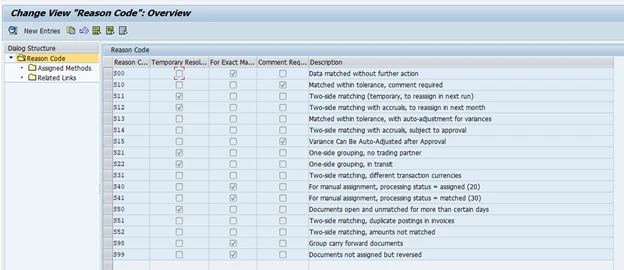
Document matching typically has a reason code to explain the assignment reason and determine any follow-ups.

Provide Workflow ID if relevant. Later, when the reason code is assigned, the relevant workflow will be triggered. SAP delivers the scenario “WS78500087” for G/L posting approval.
7. Define GL Posting Document template and assign to companies
The G/L posting document templates are used to adjust the differences between amounts of seller's accounts receivable and buyer's accounts payable.
Transaction Code: ICADT
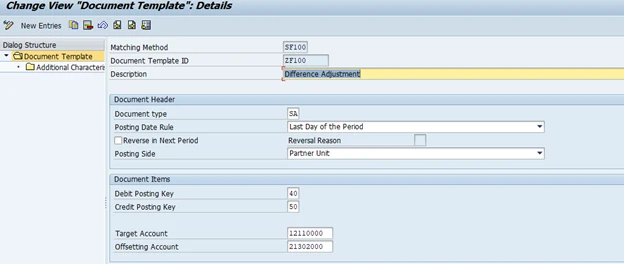
Assign Document Templates to Companies.
This step is not needed if you use Posting Rules.
Transaction Code ICAADT

If you leave it blank, the template is assigned to all Companies, Trading partners, Reason Codes.
8. Workflows for difference adjustments
To adjust differences. workflow scenario WS78500087 is delivered. You can define workflows for the auto-adjustment process with SAP Fiori app Manage Workflows - Intercompany Variance Adjustment. You can find pre-delivered workflows.
9. Activate Reconciliation Close Process
Using transaction code ICAARC we have to activate the close process for the relevant reconciliation cases.

Here, the reconciliation case for which the close process can be activated and Activate the close process. If there is any check rule, specify the check rule for the reconciliation to be closed and specify the triggering condition of workflow (workflow scenario ID. WS78500026 ). Specify Group Currency. Can be the system group currency (KSL).
If you activate this, it's available for selection in the Fiori app “Manage Reconciliation Close.”
10. Define Elimination Posting Rules
We can use SAP Fiori App Define Posting Rules to eliminate differences between intercompany group journal entries for Group Reporting purpose.
11. Define Elimination Methods
Elimination methods are to be defined for the reconciliation cases (based on SC_JOURNAL_ENTRIES_01 or SF_JOURNAL_ENTRIES_02 ). Elimination method connects a reconciliation case with elimination posting rules and can be assigned to a consolidation task.
For Consolidation Monitor Use transaction code: CX9EN.
To Define Elimination Methods, use transaction ICAEM

12. Define Data Sources
Transaction Code ICADS we can see pre delivered data sources. We can use them or copy and create your own.

Business Benefits of ICMR
- Real time reconciliation and errors detection
- Speed up month end closing
- Enable streamlined company to corporate closing integration
- More automatic process to save operational cost
- Multi-dimensional reconciliation with multi-valuation to support both legal and management used reconciliation
Conclusions
Without this new ICMR functionality, the reconciliation of account balances and items between partner companies may cause cumbersome and time-consuming activity during period-end closing. We had little transparency with respect to the reasons for variances and the reconciliation status. In some cases, tools are adequate to carry this reconciliation activity. Clear guidelines are not available for settlement processing.
SAP S/4HANA new functionality ensures that the intercompany documents from all accounting transactions within the corporate group correspond to one another. It contains the tools to check that the documents have been correctly assigned to a business transaction. This also enables you to find corresponding documents easily and make additional assignments.